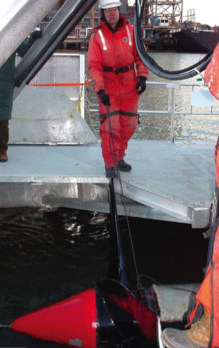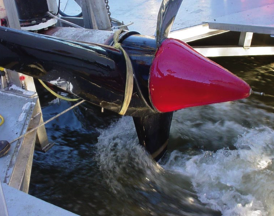Back Issues

The turbines which would be used on the Roosevelt Island tidal project in New York City's East River are about five meters in diameter and have three blades. Turbine units are mounted on swivels which allow the turbines to turn and face into the current as the tides change from incoming to outgoing. Tidal power in the Big Apple Verdant Power is working on a tidal power project in New York City's East River that could eventually see 300 turbines generating enough electricity for 8,000 homes, possibly giving New York the title of having the most renewable energy of any city in the world. By Vicky Boyd The theory behind the Roosevelt Island tidal project is simple: generate 10 megawatts of electricity from changing tidal flows in New York City's East River using 300 underwater turbines that resemble windmills. But the path to achieving that goal is anything but smooth as Verdant Power LLC of Arlington, Virginia, has to convince state and federal regulators that the project won't harm the environment before each of the three phases can proceed. "What's slowing the deployment of a lot of these technologies is the uncertainty about the environmental impacts," says Glenn Cada, a senior water resources researcher at the Oak Ridge National Laboratory in Oak Ridge, Tennessee. "Many of these designs are new concepts, and their environmental impacts have never been studied. So there are reservations about quickly installing large numbers of unconventional turbines without concurrent environmental monitoring and research. "Wind farms provide a good analogy. Many of them seem to be pretty innocuous in terms of environmental impacts. But there are instances where wind turbines have been sited in the wrong place and have caused serious bird mortality from blade strikes." Trey Taylor, Verdant president and cofounder, says company officials are fully aware of the environmental concerns. That's why they're taking the slow, multi-phase approach and collaborating with state and federal regulatory agencies as well as research institutions. "We've spent four years working with regulatory agencies and the community to do this prep work, so that is what gives us the confidence," Taylor says. Among the groups involved are the U.S. Fish and Wildlife Service, National Marine Fisheries Service, U.S. Coast Guard, U. S. Army Corps of Engineers, U.S. Environmental Protection Agency, New York Department of Environmental Conservation, the Federal Energy Regulatory Commission, Oak Ridge National Laboratory, New York City Department of City Planning and Brooklyn College. "The way to get these systems right is to have this collaboration," Taylor says. "Once we get the equipment set up, we'll ask Riverkeeper (a local environmental group) to monitor alongside of us because they might see something we don't see. We got the community involved early on, and we're making this a community project." The New York State Energy Research and Development Authority has invested more than $2 million so far in the Roosevelt Island Tidal Energy Project. If it proves successful, New York state residents could see more projects like it. New York University estimates that nearly 600 MW of electricity can be generated from kinetic hydropower in the state. The state development authority has an even loftier estimate of 1,000 MW. Of that, Verdant officials have targeted about 500 MW for development. Nearly four years ago, Verdant began exploring energy development in the east channel of New York City's East River, where tidal flows can reach up to four knots. The initial phase involved feasibility and engineering tests with a three-meter rotor deployed on the river's surface. The turbine generated up to 16 kW. Verdant also has spent the past 18 months working with regulatory agencies to assess their environmental concerns and possible monitoring requirements. As part of those discussions, the Virginia-based company provided more than 1,500 pages of project description, potential impacts and a proposed 18-month study plan for a six-turbine test. The 18-month study will require Verdant to conduct studies on fish movement and protection, navigation and security, recreational resources, historical resources and water quality. One area of concern is whether the turbine blades could kill resident fish. The East River is home to an estimated 54 fish species, of which the striped bass is popular among sport anglers. "The main concern seems to be with striped bass, but because these blades are turning so slowly, we're not worried about that," Taylor says. Conventional hydro turbines, which turn at 600 to 700 rpm, are known to entrain fish, and the fish have little room to escape. The five-meter, blunt-tipped tidal turbines, on the other hand, turn at 32 rpm, allowing fish plenty of time to move aside. As part of its preliminary work, Verdant officials spent six months conducting "snatch and grab" net surveys where they capture fish, inventory the species and size, and then release them. Despite fishermen's claims that striped bass are prevalent in the river, Taylor says they've only caught a total of three during three surveys. 
Water current turns the blades up to 32 rpm, depending on the flow. The blades turn a speed increaser, or gearbox, which drives a three-phase induction generator that can produce 16 to 32 KW of electricity. They also used boats equipped with fixed and mobile hydroacoutic transducers to determine baseline fish populations. Fishery biologists at the Oak Ridge lab and the consulting firm of Devine Tarbell and Associates in Portland, Maine, designed the fish surveys in collaboration with fishery agencies. Beginning with the second phase, Verdant will monitor fish behavior and movement around the clock for 18 months using 18 hydroacoustic sensors, which cost about $1.5 million. For the first six months, Verdant also will conduct monthly mobile surveys and netting throughout the study area. Then it will move to quarterly surveys. In addition, Verdant has asked Brooklyn College to be part of the monitoring. As part of a community partnership, the electricity will be delivered at no charge to Gristede's Supermarket and the Roosevelt Island Operating Corporation parking garage. The second phase involves installing a total of six axial-flow turbines north of the Roosevelt Island Bridge, which links Roosevelt Island to the New York City borough of Queens. The turbine units will be at least five feet below the low-tide water level so they wouldn't create eyesores or hinder stray recreational river craft. Nevertheless, Verdant will install two buoys and a security boom to keep boats out of the area. Initially, Verdant will install two turbines placed 40 feet apart in the free flowing portion of the river. The distance between the two should allow fish to pass easily. Taylor says he believes "the fish will sense the pressure coming toward them, and they will just turn away." Each turbine is about five meters in diameter and contains three blades. The unit is mounted on a swivel, which is attached to a monopile screwed into the bedrock of the channel. The swivel allows the turbine to turn and face into the current as the tides change from incoming to outgoing. Water current turns the blades up to 32 rpm, depending on the flow. The blades turn a speed increaser, or gearbox, which drives a three-phase induction generator that can produce 16 to 32 KW of electricity. The estuary has two high tides and two low tides daily, allowing for generation about 18 hours out of every 24, Taylor says. That differs from wind generation, which is unreliable since winds are unpredictable. Although the tidal units resemble windmills, Taylor says they differ because the nosecone of the water units faces into the current and the blades trail. With windmills, the blades face into the wind current. Dean Corren, Verdant's director of technology, designed the turbines in the 1980s when he was with New York University's applied science department. The university eventually pulled the plug on the project, but he continued to have faith in the project. The side-by-side tidal test turbines will operate at the same speed for two months. Then, the Department of Environmental Conservation in Albany, N.Y., will have 30 days to study the data before determining whether Verdant can proceed with the other four turbines. The turbines will be installed in three rows spaced 100 feet apart with two units 40 feet apart in each row. Altogether, they'll take up an area about 77 feet wide and 217 feet long. After the 18-month study period, Verdant plans to submit its data to the Federal Energy Regulatory Commission in hopes of receiving a license. Although Taylor says he's confident of the project's success, it also has built-in safety nets. "If we do run into environmental problems, we can stop [the turbines] and bring them out of the water faster than they went into the water," he says. Even after they receive the FERC permit, Verdant plans to install the turbines slowly to ensure there are no environmental impacts. "If the six [turbines] don't impact fish passage, could the 300 impact fish migration?" Taylor asks. "We'll continue to study it and build slowly. If something happens, we'll back off." If all goes well, Taylor says Verdant hopes to have the $10 million to $20 million project completed by 2008. The 300 turbines could generate enough electricity for 8,000 homes. Although Berlin claims to have the most renewable energy of any city in the world, Taylor says he thinks New York has the potential to be close behind. "If we complete this one project, there are two or three more sites within Manhattan," he says. Verdant currently is discussing with Nova Scotia Power an even larger project to harvest tidal-generated energy in the Bay of Fundy, Nova Scotia. Nova Scotia Power of Halifax already has one of the world's three tidal energy plants--Annapolis Tidal Generating Station at Annapolis Royal, Nova Scotia. November/December 2006 |








